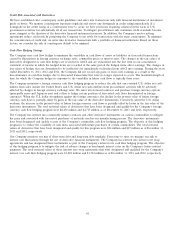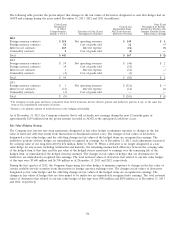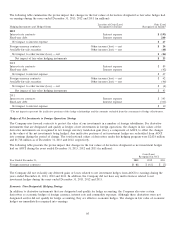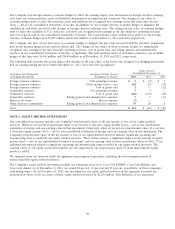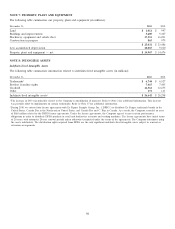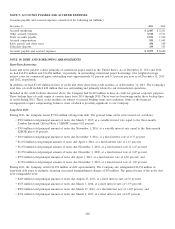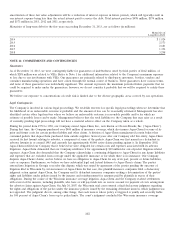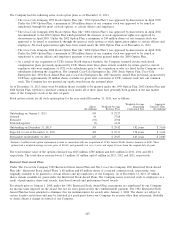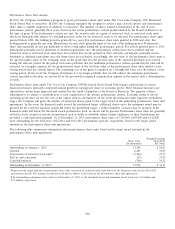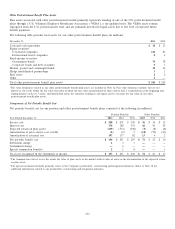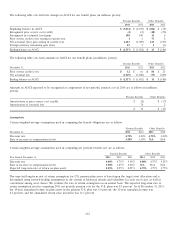Coca Cola 2013 Annual Report Download - page 105
Download and view the complete annual report
Please find page 105 of the 2013 Coca Cola annual report below. You can navigate through the pages in the report by either clicking on the pages listed below, or by using the keyword search tool below to find specific information within the annual report.litigation. The Georgia litigation remains subject to the stay agreement. The Company and Aqua-Chem continued to negotiate
with various insurers that were defendants in the Wisconsin insurance coverage litigation over those insurers’ obligations to defend
and indemnify Aqua-Chem for the asbestos-related claims. The Company anticipated that a final settlement with three of those
insurers (the ‘‘Chartis insurers’’) would be finalized in May 2011, but such insurers repudiated their settlement commitments and,
as a result, Aqua-Chem and the Company filed suit against them in Wisconsin state court to enforce the coverage-in-place
settlement or, in the alternative, to obtain a declaratory judgment validating Aqua-Chem and the Company’s interpretation of the
court’s judgment in the Wisconsin insurance coverage litigation. In February 2012, the parties filed and argued a number of cross-
motions for summary judgment related to the issues of the enforceability of the settlement agreement and the exhaustion of
policies underlying those of the Chartis insurers. The court granted defendants’ motions for summary judgment that the 2011
Settlement Agreement and 2010 Term Sheet were not binding contracts, but denied their similar motions related to plaintiffs’
claims for promissory and/or equitable estoppel. On or about May 15, 2012, the parties entered into a mutually agreeable
settlement/stipulation resolving two major issues: exhaustion of underlying coverage and control of defense. On or about
January 10, 2013, the parties reached a settlement of the estoppel claims and all of the remaining coverage issues, with the
exception of one disputed issue relating to the scope of the Chartis insurers’ defense obligations in two policy years. The trial
court granted summary judgment in favor of the Company and Aqua-Chem on that one open issue and entered a final appealable
judgment to that effect following the parties’ settlement. On January 23, 2013, the Chartis insurers filed a notice of appeal of the
trial court’s summary judgment ruling. On October 29, 2013, the Wisconsin Court of Appeals affirmed the grant of summary
judgment in favor of the Company and Aqua-Chem. On November 27, 2013, the Chartis insurers filed a petition for review in the
Supreme Court of Wisconsin, and on December 11, 2013, the Company filed its opposition to that petition. Whatever the
outcome of the Chartis insurers’ appeal to the Wisconsin Supreme Court, the Chartis insurers will remain subject to the court’s
judgment in the Wisconsin insurance coverage litigation.
The Company is unable to estimate at this time the amount or range of reasonably possible loss it may ultimately incur as a result
of asbestos-related claims against Aqua-Chem. The Company believes that assuming (1) the defense and indemnity costs for the
asbestos-related claims against Aqua-Chem in the future are in the same range as during the past five years, and (2) the various
insurers that cover the asbestos-related claims against Aqua-Chem remain solvent, regardless of the outcome of the
coverage-in-place settlement litigation but taking into account the issues resolved to date, insurance coverage for substantially all
defense and indemnity costs would be available for the next 10 to 15 years.
Indemnifications
At the time we acquire or divest our interest in an entity, we sometimes agree to indemnify the seller or buyer for specific
contingent liabilities. Management believes that any liability to the Company that may arise as a result of any such indemnification
agreements will not have a material adverse effect on the Company taken as a whole.
Tax Audits
The Company is involved in various tax matters, with respect to some of which the outcome is uncertain. These audits may result
in the assessment of additional taxes that are subsequently resolved with authorities or potentially through the courts. Refer to
Note 14.
Risk Management Programs
The Company has numerous global insurance programs in place to help protect the Company from the risk of loss. In general, we
are self-insured for large portions of many different types of claims; however, we do use commercial insurance above our
self-insured retentions to reduce the Company’s risk of catastrophic loss. Our reserves for the Company’s self-insured losses are
estimated through actuarial procedures of the insurance industry and by using industry assumptions, adjusted for our specific
expectations based on our claim history. The Company’s self-insurance reserves totaled $537 million and $508 million as of
December 31, 2013 and 2012, respectively.
Workforce (Unaudited)
We refer to our employees as ‘‘associates.’’ As of December 31, 2013, our Company had approximately 130,600 associates, of
which approximately 66,800 associates were located in the United States. Our Company, through its divisions and subsidiaries, is a
party to numerous collective bargaining agreements. As of December 31, 2013, approximately 18,000 associates, excluding seasonal
hires, in North America were covered by collective bargaining agreements. These agreements typically have terms of three to five
years. We currently expect that we will be able to renegotiate such agreements on satisfactory terms when they expire. The
Company believes that its relations with its associates are generally satisfactory.
103


